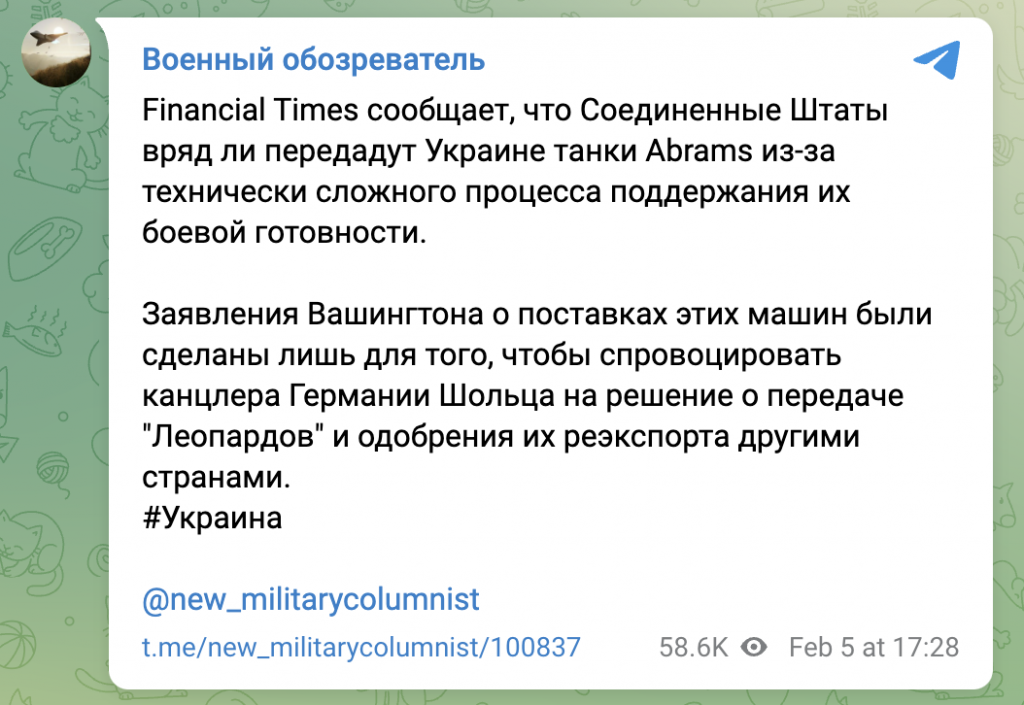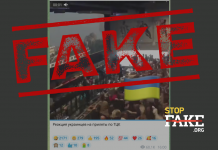The Financial Times article cited in this latest Russian fake claiming the US is unlikely to actually send Abrams tanks to Ukraine, features several experts, some of whom said that Ukraine may face difficulties using the Abrams tanks. However, neither the author of the article nor the experts featured in the story ever said that the United States could “refuse to transfer Abrams tanks to Ukraine because of the technically complex process of maintaining their combat readiness.”
Some Telegram channels and social media users are citing the Financial Times, while spreading claims that the United States is “unlikely to transfer Abrams tanks to Ukraine” because the technical process of maintaining their combat readiness is difficult. The Russian media’s interpretation of the Financial Times article was much more categorical – they claim that experts cited by the Financial Times are unanimous about Abrams tanks being “not suitable for the Ukrainian army due to maintenance difficulties.”


On January 5, 2023 the Financial Times featured an article titled A problem of logistics: is the US sending Ukraine the wrong tank?
Neither the article’s author, Steff Chavez, nor any of the experts interviewed in the story ever state that the US “is unlikely to sent Ukraine Abrams tanks because they are complicated to maintain”. On the contrary, the article confirms that after long discussions and requests from Germany and Ukraine, the US has decided to send 31 Abrams M1 tanks to Ukraine, that is the equivalent of one Ukrainian tank battalion.
Using the Abrams tank as an example, the Financial Times article focuses on how the American defense procurement system often overcomplicates its big military platforms. Several of the analysts cited in the article note that the Pentagon’s love for advanced technologies carries many difficulties, from increasing the defense budget to problems with logistics and equipment maintenance. The Ukrainian military may also face some of these same difficulties – for example, the Abrams has a very sensitive gas turbine engine, very high fuel consumption and requires a constant supply of spare parts.
“There’s a bias in the Pentagon to buy the most exquisite defence [systems]” but other countries “just need whatever can get the job done,” said Josh Kirshner, a managing director at Beacon Global Strategies, a strategic advisory firm.
It should be noted that the Russian media cite only those experts quoted in the Financial Times who expressed concern that Ukraine might not be able to cope with the maintenance of the Abrams tank. At the same time, some analysts, whose views were ignored by the Russian media, said that many US weapons systems work exactly as advertised. For example, Lauren Thompson, chief operating officer of the Lexington Institute think tank, emphasized that “these concerns are exaggerated,” and criticism of the US weapons system itself often consists of stereotypes.
Some analysts pointed out that if we compare the Abrams and Leopard tanks in the conditions of the Ukrainian war, the Leopards come ahead, as they are available in Europe, run on diesel and are easier to learn to operate for a new crew.
StopFake has debunked previous Russian fakes on the topic of western tanks supplied to Ukraine, such as the story claiming that the UN is unhappy with the delivery of western tanks to Ukraine.





